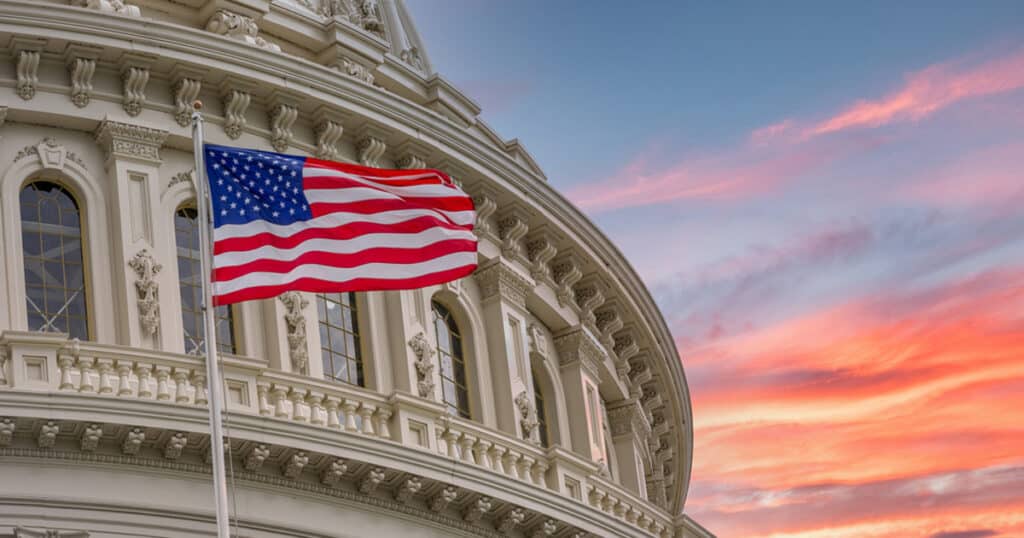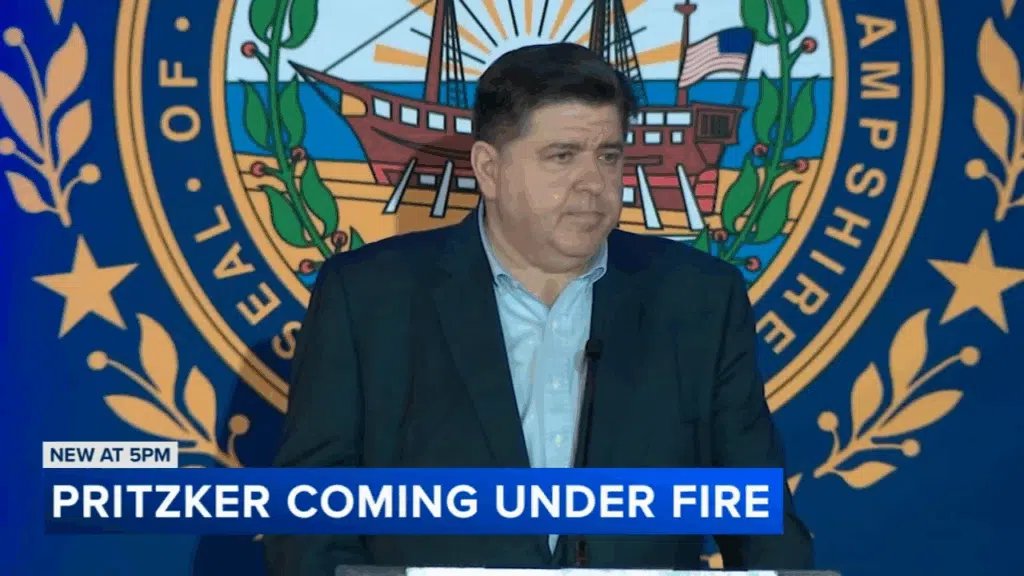
Biden White House Uses Fuzzy Math to Tout ‘Nearly 20%’ Federal Union Growth
President Biden has vowed to be the “most pro-union president in history.” And one sector over which he has a lot of control is said to be bucking the decades-long trend of union decline in a big way: The ranks of unionized federal government employees swelled by nearly 80,000 to about 497,000 dues-paying members – a 20 percent increase – according to an Office of Personnel Management spokesman.
The White House touted this trend in a March update on the work of Vice President Kamala Harris’s White House Task Force on Worker Organization and Empowerment.
But in reporting this story, RealClearInvestigations found cause for doubt: Publicly available figures on federal union membership – including those federal employee unions themselves report by law – look far less impressive than the Biden administration’s data.
The two largest such unions, which account for more than three-quarters of the reported nearly 500,000 unionized federal employees, are the American Federation of Government Employees and the National Treasury Employees Union.
In 2022, the American Federation reported 298,102 such employees on its Form LM-2, a legally required annual financial disclosure report filed with the U.S. Department of Labor. This represented a slight decline from its 2021 membership number of 298,873.
The National Treasury Employees Union reported 82,860 members in 2022, up marginally from its 2021 membership number of 79,787. The net increase in membership across these two unions, therefore, totaled just 0.6%.
So where’s the reported nearly 20% jump in unionized federal employees?
James Sherk, a labor economist who served on the Trump administration’s domestic policy council, told RCI the figures from the two unions were “highly inconsistent” with those of the Biden administration.
“Unless you’ve got some minor unions doubling or more their membership while nothing similar is happening with the largest unions,” Sherk said, “there’s just no way to make the math work.”
RCI asked the Office of Personnel Management, which compiled the figures reported by the White House, if it could provide a breakdown of membership gains by union to help reconcile this seeming discrepancy.
In an email, an agency spokesman replied that “OPM is provided aggregate level data for the Executive Branch through payroll providers. OPM has not been provided data by union.”
The White House’s unionization figures also do not seem to jibe with those of the Bureau of Labor Statistics.
The bureau reported only a 21,000-worker increase in federal union employment – up just 2.2% – between 2021 and 2022.
OPM, the federal government’s chief human resources agency, says the numbers at issue are apples and oranges: “BLS data includes other categories of employees not counted in OPM’s data, such as the hundreds of thousands of postal employees represented by labor unions, as they are not covered by OPM’s worker organizing and empowerment guidance,” an Office of Personnel Management spokesman explained.
But UnionStats.com, a database put together by academics analyzing Current Population Survey data, found that by removing postal service workers, the number of unionized federal employees increased by only 1% from 2021 to 2022.
Still more basic differences between these data sources produce more murkiness than clarity.
The Bureau of Labor Statistics derives its unionization data from its Current Population Survey, which samples about 60,000 eligible households, whereas the Office of Personnel Management collects data directly from government agencies and payroll providers.
Consequently, these sources report significantly different numbers when it comes to foundational statistics such as unionized federal employees and total federal employees.
After RCI initially contacted Sherk in connection with this story, the labor expert, now a director at the America First Policy Institute, investigated for himself the seeming incongruity between the Biden White House figures and the unions’ reported figures.
On May 3, Sherk published a report on the seven largest exclusively federal unions – with 413,000 employees, nearly equal to the 417,000 federal employees the OPM reported as members of unions in 2021. It found those unions experienced an increase of a mere 1,500 members, or less than one-half of one percent, between 2021 and 2022.
After completing his analysis, Sherk told RCI: “I suspect the White House knows their figures are wrong but doesn’t want to admit it.”
The Office of Personnel Management did not reply to RCI’s multiple requests for clarification on the Biden administration’s figures. Nor did the vice president’s office.
When asked whether it was seeing increases in federal unionization rates consistent with those reported by the administration, a spokesman for the American Federation of Government Employees told RCI:
Since the toughest days for federal sector union organizing during the union-busting Trump administration, AFGE has gone from organizing between 2,500-3,500 new members per month to organizing between 4,000-5,500 new members per month. Because there is a tremendous amount of churn in an employer as big as the federal government, we also lose a significant number of members each month due to promotions, retirements, and other routine changes in employment. However, AFGE has had net growth for 11 of the past 12 months. The last two months we’ve had net gains of over 1,000 members per month, and this month we’re on track for the same.
“In short,” the spokesman concluded, “we’re seeing a much better environment for union organizing in the federal sector due to a host of factors, including actions taken by the Biden administration, and we’re proud to be a growing union.”
The National Treasury Employees Union did not respond to a similar inquiry.
Reform and Counter-Reform
But the iffy numbers don’t mean the Biden administration isn’t trying hard to grow the ranks of unionized federal employees. It has launched myriad initiatives including an extensive “Know Your Rights” effort aimed at promoting unionization to new and existing employees, and made it easier for organizers to operate on federal property and federally controlled spaces. These efforts flow from the Task Force’s final report, which proposed 70 strategies “to reduce barriers to worker organizing in all sectors” – all of which the president approved.
From its earliest days, the Biden administration established its broader mission to “protect, empower, and rebuild the career Federal workforce” in a Jan. 22, 2021 executive order.
That order called for the federal government to “encourage union organizing and collective bargaining.”
The order also reversed efforts of the Trump administration seen as detrimental to federal labor unions.
Among the measures Biden immediately rescinded were a trio of executive orders dating back to 2018 that the Trump administration said would “make it easier to remove poor-performing employees and ensure that taxpayer dollars are more efficiently used.”
One order sought to reduce the time by which federal employees could be paid for union work while “on the clock,” and another to streamline the federal sector collective bargaining process.
Federal labor unions cried foul, with then-president of the American Federation of Government Employees J. David Cox calling the orders “retribution on an apolitical civil service workforce,” and his National Treasury Employees Union counterpart Tony Reardon describing the orders as “an assault on federal employees.”
Perhaps more significantly, Biden also rescinded a still more ambitious October 2020 executive order “Creating Schedule F in the Excepted Service.” That order called for agency heads to re-classify career federal employees in positions “of a confidential, policy-determining, policy-making, or policy-advocating character” as Schedule F employees.
This would have made it significantly easier for the president to remove employees deemed ineffective or actively opposed to the policies of the administration – stripping them of civil service protections that critics argue make federal employees nearly invincible, and treating them more like at-will employees.
Philip K. Howard, author of the recent book “Not Accountable: Rethinking the Constitutionality of Public Employee Unions,” told RCI that because of the procedures built into the Civil Service Reform Act of 1978, “99% of all federal employees get a fully successful job rating because if you put anything negative in a file…the employee has a right to file a grievance and the union will defend [them] and the supervisor has to…justify it [derogatory ratings] in hearings before arbitrators.”
Federal unions contend that such civil service protections are about ensuring due process. “Due process,” says Howard “is code for you can never get fired.” He has cited as an example an EPA employee “caught red-handed surfing porn sites in his cubicle, [who] was paid for almost two years until he made a deal to retire.”
Trump’s Schedule F effort also drew the ire of critics, with the National Treasury Employees Union filing suit.
A Decidedly Skeptical GOP Field
As a 2024 presidential candidate, Trump has suggested that he would revive the executive order, making up to 50,000 federal workers fireable in a bid to combat a bureaucracy he sees as intransigent to him and his policy goals.
Other prominent Republicans have indicated their desire to exert greater control over the federal bureaucracy as well, with recent Republican presidential candidate Florida Governor Ron DeSantis explicitly expressing his support for the creation of a Schedule F earlier this year.
RCI sought comment from other Republican presidential candidates regarding their views on civil service reform.
Former U.S. Ambassador to the United Nations and South Carolina Gov. Nikki Haley told RCI: “We must always remember that federal workers are paid by taxpayers. The Biden hyper-unionization approach hurts taxpayers and doesn’t help federal workers. It only helps Democratic politicians who raise big money from big union bosses.”
Her fellow South Carolinian, Sen. Tim Scott, has long been a proponent of right-to-work legislation and school choice – positions disfavored by public sector unions.
An indicator of former Arkansas Gov. Asa Hutchinson’s position on public-sector unions can be seen in his signing of a 2021 bill prohibiting state employees from collectively bargaining.
And in a recent podcast interview with Howard, entrepreneur Vivek Ramaswamy called the administrative state “the single greatest threat to our constitutional republic.”
Consistent with the wishes of the Biden administration, congressional Democrats have sought to pre-empt any future Schedule F push through barring it legislatively, while Republican counterparts have introduced even more ambitious legislation aimed at making all executive branch employees at-will.
The Cash Cow of Union Dues
Federal unions, first granted the power to organize via an executive order issued by President John F. Kennedy in 1962, overwhelmingly contribute to Democrats, though at lower levels than unions representing state and local employees. And the White House Task Force sees opportunity to grow that power base: OPM’s FedScope database says only a little more than half of all 2.2 million non-postal civilian federal employees belong to one of about 70 unions – totals that have held steady since the Trump administration.
In the 2022 election cycle the American Federation of Government Employees and National Treasury Employees Union contributed a combined $2.4 million to federal candidates, parties, and outside groups – more than 95% of which went to Democrats. By contrast, the National Education Association made more than $23 million in political contributions, just under 99% of which went to Democrats, according to OpenSecrets.
The sums spent annually on political activities and lobbying among federal employee unions are significant. The American Federation of Government Employees reported $6.3 million in disbursements on political activities in lobbying during 2022, and the National Treasury Employees Union reported $3.6 million.
To the extent the unionized federal worker population increases, this would mean more money in unions’ coffers to support Democrats and shared causes – political support funded by taxpayers.
The consequence, says Sean Higgins of the libertarian Competitive Enterprise Institute, is that federal union “growth will make any future effort to rein in the regulatory state that much harder. Unions will step in to protect the status quo since any change will likely mean fewer members, and therefore less revenue and power, for the union.”
Jason Briefel, director of Government & Public Affairs at Shaw Bransford & Roth, and editor-in-chief of the FEDagent and FEDmanager newsletters, told RCI, “The Biden administration has bent over backward to help preferred employee organizations succeed … directly assisting federal employee unions in growing their membership ranks as a reward for partisan political support.”
This behavior came to the fore when the National Federation of Federal Employees’ website put out a press release thanking the Biden administration for helping it recruit more federal workers – only to later pull the document down.
Mark Mix, President of the National Right to Work Committee, added that “making this blatant political backscratching even more egregious is the fact that at the federal level taxpayers already fund federal union activities to the tune of hundreds of millions of dollars through the corrupt practice of ‘official time,’ in which union officials who are ostensibly employed by the government are paid with tax dollars to conduct union business.”
“The other more fundamental problem,” Mix adds “is that increased union control over government workers is fundamentally anti-democratic, forcing future administrations to bargain with union officials who are completely unaccountable to citizens over how public policy is enacted.”
Briefel concurs, noting that “This behavior seems contrary to the idea of a democratic government that treats all citizens and groups equally. It is also contrary to the merit system, which judges an employee’s worth–not based on their partisan affiliation–but on their skills and abilities.”
Government Shutdown Politics
For their part, federal unions seem to be gearing up for a fight – one they will perhaps be better equipped to win should the Biden administration’s efforts to swell their ranks bear fruit. That would be welcome news for them at a time when the U.S. unionization rate has fallen to an all-time low – 10.1% in 2022 – with private sector rates remaining particularly depressed – despite widely covered unionization efforts at Apple, Amazon and Starbucks, and the organizing efforts of journalists providing such coverage.
In February, Everett Kelley, president of the American Federation of Government Employees, warned about the fight ahead, referring to House Republicans when he said, “If these extremists want to cut any of these essential government functions, we’re going to rise up and alert the American people of the harm they’re threatening.”
He added, “If they force another shutdown, we’ll rise up and remind people about what we do, why it’s so important to their lives, and why these maniacs, if you will, must be held accountable. We must go on offense.”
In April, his organization would pan House Republicans’ debt ceiling proposal, as would the National Treasury Employees Union.
As the debt ceiling fight intensified, another federal union, the National Association of Government Employees, filed suit challenging the law capping government debt and seeking to prevent the Biden administration from defunding any federal government operations absent congressional direction.
A debt ceiling-related fight may be averted, but federal employee unions’ aggressive posture may still bear out in appropriations debates.
In fact, unions such as the American Federation of Government Employees have even taken issue with Democrat proposals, for example urging a wage increase to 8.7% from the 5.2% figure called for in President Biden’s fiscal year 2024 budget.
Briefel sees partisan differences over federal unions to be the ultimate stumbling block to needed congressional reform.
“Republicans center discussions around accountability and refuse most reforms that come with a price tag, and union-backed Democrats refuse to open the door on accountability,” he said. “In the end, neither party has an incentive to work together on these issues.”
“Congress,” he added, should “be the leader on genuine civil service modernization.”
This article was originally published by RealClearInvestigations and made available via RealClearWire.



